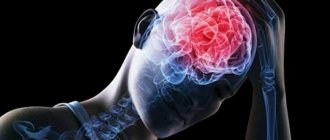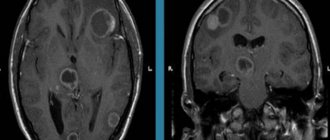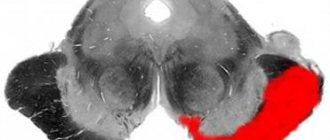This group of mental disorders includes diseases associated with short-term or permanent disturbances that occur to a person against the background of the influence of various traumatic factors on the brain.
These may be causes directly affecting the brain (trauma, neurotropic viruses, toxins), or factors associated with secondary lesions (blood or vascular diseases that lead to starvation of neurons and inhibition of their activity, endocrine diseases, brain tumors and etc.).
The causes of organic damage can be:
- Traumatic brain injuries (concussion, bruises, slaughter)
- Degenerative diseases (Alzheimer's, Pick's, Huntington's, senile dementia)
- Vascular pathology (hypertension, cerebrovascular accidents - ischemic and hemorrhagic strokes, rheumatic diseases)
- Brain tumors
- Infections (tick-borne encephalitis, syphilis, HIV, herpes virus)
- External intoxication (alcohol, drugs, toxic substances - glue, household solvents)
Organic brain damage – relationship with functional disorders
Historically, earlier in psychiatry, all mental illnesses were divided into organic (in which the substrate can be identified - the site of the lesion, the cause of the process) and functional (which are caused exclusively by social and behavioral factors).
However, with the development of medicine, this division lost its relevance and showed that exclusively organic and exclusively functional disorders are rarely encountered.
For example, post-traumatic stress disorder (PTSD) used to be considered purely functional, since its cause was the direct fact of suffering mental trauma. Now it has been proven that the emergence and development of PTSD is associated not only with the presence of mental trauma, but also with certain characterological characteristics of the individual, including those of an organic nature, the so-called. pathoplastic basis (organic lesions at the subclinical level, preceding the manifestation of PTSD, such as post-infectious processes, trauma during childbirth, etc.).
Modern instrumental studies have now proven that patients with panic disorder exhibit diencephalic insufficiency.
According to G.L. Voronkov, there are practically no organic mental disorders in their pure form; they are always a combination and interpenetration of organic and functional symptoms.
Social factors
Social factors of dysontogenesis include:
1) various types of emotional and social deprivation;
- various kinds of social psychological stress.
Among the factors unfavorable for a child’s development are mental deprivation
,
attachment disorders
and
separation
.
Mental deprivation
is a mental state that arises as a result of certain conditions when the subject for a long time is not given the opportunity to satisfy basic psychosocial needs to a sufficient extent.
Highlight:
— maternal (emotional) deprivation that occurs in early childhood due to insufficient contact with the mother;
— sensory deprivation due to deprivation of information necessary for life;
23 pages, 11178 words
Abstract – Types of mental development disorders
... patients with organic diseases accompanied by a wide range of psychopathological reactions and autonomic disorders. With them... realized in conditions of constant change of environmental factors. Mental development is closely related to the biological properties of the body... talk about the interest of the cerebral cortex. It should be noted that peripheral vegetative...
— social deprivation caused by insufficient contacts with the environment.
In all cases of deprivation, the child’s mental development does not stop, but he experiences a state of mental, although perhaps unconscious, suffering and discomfort: by analogy with malnutrition, some authors define deprivation as mental starvation.
Characteristic deprivation symptoms:
- delay and distortion of intellectual development;
— emotional disorders and distortions in the formation of emotions;
— volitional disorders (from decreased activity to pronounced passivity);
- communication disorders (from mild autistic tendencies to the so-called paraautism as a persistent condition);
- motor stereotypies and habitual actions while awake (for example, thumb sucking, rocking, masturbation, etc.);
— disorders of the instinctive sphere and functional somatovegetative manifestations (appetite disorders, sleep disorders, etc.).
The depth and severity of symptoms are individual depending on the timing of deprivation, its duration and intensity. It has been established that the first years of life are the most sensitive to deprivation effects. The experience of deprivation depends on the gender of the child - boys are more reactive. The constitutional characteristics of the psyche also play a role - the level of activity of the child, the regularity or irregularity of biorhythms, adaptability; genetic predisposition to any mental or somatic diseases that can be provoked by conditions of deprivation is of particular importance. Finally, the presence of minimal brain dysfunction causes additional internal deprivation effects due to perceptual and motor impairments, even mild ones.
Attachment disorders.
Attachment to mother is normally formed by 7-8 months. and can manifest itself to other people interacting with the child.
Research has identified three main types of attachment:
- ambivalent - children are not sure of their reaction to their mother and hesitate, sometimes trying to attract her attention, sometimes rejecting it;
- withdrawn - children push away their mothers, who seem too stimulating and intrusive to them;
- stable - children grow up warm-hearted and sensitive, and their mothers, as a rule, are affectionate and responsive.
Inadequate or inconsistent satisfaction by the mother of the child’s basic needs leads to a distortion in the formation of attachments and the appearance of specific symptoms. When severe, they are diagnosed according to ICD-10 as “reactive attachment disorder of childhood.”
With attachment disorders, two opposite patterns are observed in the behavior of different children: a persistent reluctance to enter into contact or maintain relationships with surrounding adults, an apathetic or depressed background mood, wariness or “diffuse sociability” - a desire to communicate with almost all people, attracting attention to oneself. This variant is called “disinhibited attachment disorder” in the ICD-10. Such deviant development is typical for children in orphanages.
20 pp., 9852 words
The influence of deprivation on the mental development of personality in childhood
... Subject of research: the influence of deprivation on the mental development of personality in childhood. Purpose of the study: to study the features of the influence of various types of mental deprivation on the development of a child’s personality. As a hypothesis... S. Freud noted that at the age of four or five years, a child develops a strong sexual attachment to his mother. Attachment to and dependence on the mother figure is...
In 1951, J. Bowlby introduced the concept of “ separation
” to indicate a situation of long-term separation of a child from his mother or another person taking her place. This situation is especially serious for children in the first 3-5 years of life. Bowlby believed that separation influences the child’s development of a normal sense of anxiety. He identifies the three most typical phases of separation for children from 7 months. up to 4 years of age when placed in a 24-hour nursery, hospital or orphanage. In one form or another, however, these phases can be observed at earlier and older ages:
- “protest” phase: the child calls his mother by crying, does not let her go when she comes to visit him, sometimes shows signs of panic;
— “despair” phase: the child becomes depressed, self-absorbed, sleep and appetite disturbances are noted, he may suck his fingers, rock, and perform other stereotypical actions;
- “alienation” phase: the child loses interest in the object of attachment, there is a loss of need for him.
These phases are not necessarily sequential, but rather intertwined.
In conditions of round-the-clock stay in nurseries, orphanages, hospitals or sanatoriums, a child cannot get used to it, become attached, or feel protected. This leads to constant anxiety, fear, and worry.
Isolation of the family from the immediate environment. Social isolation of the family due to mental illness or personality disorders of the parents prevents the child from contacting the environment, i.e. puts him in a situation of social deprivation.
Are some forms of organic damage to the cerebral cortex normal for age?
It is safe to say that old age is a risk factor for the development of atrophic processes in the brain and dementia. But when examining older people, it is discovered that most of them still do not have signs of this pathology. Based on this, it can be assumed that senile dementia and other organic brain lesions due to degenerative, vascular, and endocrine age-related disorders are not the age-related norm, despite the predisposition of older people to these diseases.
If we consider dementia, its clinical manifestations depend on a number of additional aspects: the causes of occurrence, premorbid personality traits (the character of a person before the disease), the social environment. Thus, a patient with certain types of dementia with a prosperous family environment, who is partially socially adapted, thanks to the support of loved ones, can function for a long time, unlike patients who are deprived of this opportunity.
Influence of time of exposure to a pathogenic factor on the nature and severity of mental disorder
Taking into account the chronogenic factor, the following patterns of developmental disorders are identified:
1. Damage to a developing organism is often diffuse rather than clearly localized, which is why combinations of impairments of various abilities occur.
2. The extent of damage to tissues and organs, other things being equal, is more pronounced the earlier the pathogenic factor acted.
- Different factors acting at the same time cause similar pathological conditions.
There are congenital and acquired disorders that appear after birth. Within the group of congenital disorders, a subgroup associated with hereditary pathology should be distinguished, because not everything congenital is hereditary, but everything hereditary is most often congenital. The group of acquired disorders includes early and late acquired ones. The age limit between them may be different. Thus, in cases of hearing impairment, the time of its loss relative to the timing of speech development, those stages when speech has not yet begun its formation, periods of initial development and age when speech was already relatively formed is important. This example is very indicative; it demonstrates the principle of chronogenicity of the relationship between the severity of the disorder and the time of occurrence of the main disorder. It is on the latter that the prognosis of further development, the nature and content of corrective measures, which may or may not have the possibility of relying on the period of normal functioning of the psyche, if such exists, largely depend.
Topography of organic damage
Thanks to the availability of modern instrumental imaging methods (computed tomography (CT), magnetic resonance imaging (MRI), positron emission tomography), it becomes possible to compare the clinical picture of an organic disorder and the localization of the lesion.
If the process involves predominantly the frontal parts of the brain, then aspontaneity (lack of impulses for motor, speech, mental and
other activities), as well as depressive symptoms. Previous attachments disappear, and behavior becomes disinhibited, moral standards are lost, anosognosia is observed - a complete lack of criticism of one’s actions. These patients may be characterized by moria syndrome, when they become complacent, euphoric, with a tendency to make inappropriate, vulgar and rude jokes, and play pranks.
If the orbital sections are affected, then impulsivity and lack of self-control may prevail - the character acquires features of psychopathic behavior.
When the temporal lobes are affected to a greater extent, memory is usually affected first, and mood may change.
When the parietal lobes are damaged, we can see first of all in the patient agnosia (loss of accumulated knowledge and the inability to acquire new ones), apraxia (loss of skills, such as drawing, sewing, professional developments), paralysis, paresis, etc.









